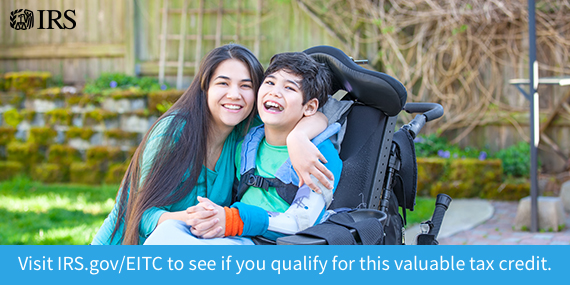If you are a taxpayer with a disability or have a child with a disability, you may qualify for a refund that puts extra dollars in your pocket.
The IRS estimates that as many as 1.5 million people with disabilities miss out on a valuable credit for low to moderate-income workers because they fail to file a tax return.
Many of these non-filers fall below the income threshold requiring them to file; however, in order to claim the EITC, you have to file a tax return— even if you don’t owe taxes for the previous year.
Those who qualify could pay less federal tax, pay no tax at all or even get a tax refund that puts an extra $2 to $6,660 into their pocket.
Eligibility for EITC
To qualify for EITC, you must have earned income from employment, self-employment or another source that does not exceed income limits (see chart on the right) as well as meet a few additional criteria explained at www.irs.gov/eitc. Social Security benefits or Social Security Disability Income (SSDI) do not count as earned income.
Disability and EITC
Taxpayers may claim a child* of any age as a qualifying child if the person has a permanent disability and you both meet all other EITC requirements. The tax law definition of totally and permanently disabled is:
- They can’t engage in any substantial gainful activity because of a physical or mental condition.
- A physician determines that the disability has lasted or can be expected to last continuously for at least a year or can lead to death.
* child: son, daughter, adopted child, stepchild, foster child or a descendant of any of them such as a grandchild; brother, sister, half-brother, half-sister, step-brother, step-sister or a descendant of any of them such as a niece or nephew.
EITC and Public Benefit Programs
The law is clear that tax refunds, including refunds from tax credits such as the EITC, are not counted as income for purposes of determining eligibility for benefits (such as Social Security disability benefits, Medicaid, and food assistance programs). This applies to any federal program and any state or local program financed with federal fund
Use the EITC Assistant at irs.gov/eitc to determine eligibility and estimate the amount of your credit.
Income Limits for Tax Year 2023:
- $56,838 ($63,398 married, filing jointly) with three or more qualifying children
- $52,918 ($59,478 married, filing jointly) with two qualifying children
- $46,560 ($53,120 married, filing jointly) with one qualifying child
- $17,640 ($24,210 married, filing jointly) with no qualifying children
Investment income must be $11,000 or less
Maximum Credit Amounts:
- $7,430 with three or more qualifying children
- $6,604 with two qualifying children
- $3,995 with one qualifying child
- $600 with no qualifying children
Remember: To claim EITC, you must file a tax return even if you owe no tax.
Find out if you qualify for EITC. Ask your tax return preparer or visit: irs.gov/eitc






